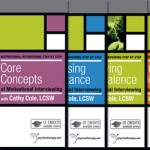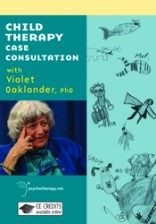Mar 21, 2013 | Video Reviews
 Psychotherapy.net and Cathy Cole have developed an impactful DVD series on Motivational Interviewing (MI). This 2012 series illustrates how motivational interviewing is a counseling approach to improve how counselors and clients have conversations. These DVDs are up-to-date and current with a natural flow to the interview conversations. The DVDs serve as a resource to introduce counselors-in-training to MI. Furthermore, the series is a refresher for counselors who have been trained in the past and need a thought- provoking experience to reaffirm the positive impact that this Rogerian-focused technique can provide. The process reinforces client autonomy as the counselor and client join together to create a matrix for change. Rather than the counselor being an ‘expert,’ Cole states that it is important to ask permission of the client to share information. The four part series covers the core principles of increasing importance, building confidence, and resolving ambivalence.
Psychotherapy.net and Cathy Cole have developed an impactful DVD series on Motivational Interviewing (MI). This 2012 series illustrates how motivational interviewing is a counseling approach to improve how counselors and clients have conversations. These DVDs are up-to-date and current with a natural flow to the interview conversations. The DVDs serve as a resource to introduce counselors-in-training to MI. Furthermore, the series is a refresher for counselors who have been trained in the past and need a thought- provoking experience to reaffirm the positive impact that this Rogerian-focused technique can provide. The process reinforces client autonomy as the counselor and client join together to create a matrix for change. Rather than the counselor being an ‘expert,’ Cole states that it is important to ask permission of the client to share information. The four part series covers the core principles of increasing importance, building confidence, and resolving ambivalence.
The first DVD, Motivational Interviewing Step by Step: Core Concepts, provides the viewer with the building blocks for conducting a MI along with the rational for each step. Victor Yalom and Cathy Cole have a smooth style of walking the viewer through the process and their conversations are highlighted by simple graphics to reinforce the basic points. The DVDs also are good to just listen to on a long drive to enhance the learning experience. For example, Cole talks about the mnemonic of those “DARN CATS” and how following these steps can result in a beneficial conversation.
Motivational Interviewing Step by Step: Building Confidence is the second DVD and helps to instill confidence in both the client and the counselor. The four principles of MI: (1) expressing empathy, (2) developing discrepancy, (3) rolling with resistance/reflecting discord, and (4) supporting self-efficacy are explained and illustrated throughout the series with clear and logical examples.
The third DVD is Motivational Interviewing Step by Step: Increasing Importance. The disc has three excellent counseling sessions by Cole who brings to life the importance of various points. For example, too often a counselor when confused about an issue will revert to asking question after question. Cole demonstrates that continued reflection is important so that the client does not feel ‘grilled.’
The fourth DVD, Motivational Interviewing Step by Step: Resolving Ambivalence, encourages the counselor to assist the client in using what is known by the client and then encouraging that more information be sought. MI helps the client explore ambivalence and look at different resources and information, which may help the client explore their thoughts. The series also is strong as it provides examples for various work environments for counselors such as EAP or agency. The clients are in various stages of counseling from initial intake to established clients so the viewers get a broad understanding of MI.
Overall, the series is well produced, informative and helps the viewer form a clear understanding of the motivational interviewing (MI) approach. Within the DVDs there are helpful meta-processing comments regarding the counseling sessions. The accompanying manuals also have wonderfully constructed discussion questions, informational summaries and transcripts of the sessions.
Motivational interviewing step by step (4 DVD series) [DVD]. Psychotherapy.net (Director) (2012). Available in DVD and Video Streaming at http://www.psychotherapy.net/MI
Reviewed by: Matthew Mims, NCC, University of Nebraska at Kearney, Kearney, Nebraska.
The Professional Counselor Journal
HOME PAGE
Feb 10, 2013 | Video Reviews

The Leading Groups with Adolescents video presents a fishbowl view of an actual psychoeducational group. The presenters carefully outline each highly structured step in the process and then proceed to facilitate each step before the camera where viewers are vicariously drawn into the process. At times, due to the actual believability of the group experience, I forgot I was a passive observer and not a member.
The participants are not actors– probably second-semester sophomores, who were chosen for training as peer mediators. It is obvious the students are high achieving, articulate and poised teens. As the leaders move the group process forward, the students become more real, more genuine, and more able to present themselves, warts and all, with more comfort and depth. To DeLucia-Waack’s credit, she acknowledges that this group of teens is probably the ideal for a psychoeducational group. Before the actual group begins, midway through the eight-hour group, and at the end, the presenters meet with Dr. Arthur Horne. As the outside moderator, he sets the stage and processes the group encounter. The articulation of counseling foundations and explanations of the authors’ purposes that he provides is certainly a strong addition to skills training.
For learning teen group psychoeducational skills, this DVD may be as valuable, or more so than a college lecture class. It’s of the A+ variety. When promoting the value of groups in comparison to individual therapy for teens, the presenters stress that adolescent groups remove the adult-as-authority impediment. These teens clearly demonstrate honest engagement with one another, and the use of preferential learning modalities to become both students and peer-teachers. The focus on the cognitive behavioral feeling-thinking-acting ABC model is, in itself, praiseworthy. For skills training in leading teen groups, this segment alone provides a vignette gem of CBT in action. In addition, the demonstration of termination is worth the price of the video.
Although the production has top-notch training potential, more cultural diversity would have strengthened the overall believability of the messages. There are only two teen male group members. The presenters, the group members and the moderator are Caucasian. Having a male and a female leader, however, is a stellar plus for modeling in teen groups. DeLucia-Waack’s energized presentation style can be both engaging and somewhat bothersome. Segrist’s restrained, almost somnolent style both negatively magnifies and positively compliments Delucia-Waack’s force. Certainly his role of getting the group physically involved in the process speaks volumes for the need for pacing, body-mind learning and active engagement in working with teen groups. As a tool, Leading Groups with Adolescents, is a worthwhile training DVD. The accompanying handbook further enhances the viewer’s ability to successfully use material from the video and actualize effective teen group work. Even with the absence of some of my personal “wants and needs,” I wholeheartedly recommend Leading Groups with Adolescents. There is icing on the cake – CEU credits are available for this video.
DeLucia-Waack, J., & Segrist, A. (Director). (2011). Leading groups with adolescents [DVD] New York, NY: Springer. Available from https://www.psychotherapy.net/video/psychoeducational-group-adolescents.
Reviewed by: J. Dwaine Phifer, NCC, DonLin Counseling Services, Statesville, NC.
The Professional Counselor
HOME PAGE
Dec 9, 2012 | Video Reviews

Dr. Sue Johnson came onto the family therapy radar screen in the early 1980s when she, along with Les Greenberg, developed a short-term, structured therapeutic approach to working with couples which emphasized emotion as the key organizer of behavior patterns and thus intimacy. Johnson’s concept was “radical” especially in the heyday of Salvador Minuchin and Jay Haley. Yet, not only did Johnson formulate a theory that combined Carl Rogers and John Bowlby’s ideas along with systemic theory, she did extensive research on her model as well – Emotionally Focused Therapy (EFT).
The first disc of this two-part film features an interview with Johnson and the producer of the video, Victor Yalom. Johnson emphasizes adult attachment theory and how EFT allows people to send clear emotional signals to their partners. Such articulation is the opposite of shutting down or becoming angry and creates a strong bond between partners. The result is not only a more secure relationship between individuals in a couple relationship, but greater independence of each individual.
Johnson states that the EFT therapist must first look at the “dance” of couples stuck in non-productivity, and especially the emotional consequences of their actions. A main focus of the therapist is to help couples understand their emotions and change them so they can ask for what they need and negative cycles of communication can be broken while positive ones are built. Johnson emphasizes the collaborative nature of EFT and its three stages: 1) deescalation, 2) creation (of a positive cycle of emotional involvement), and 3) consolidation. She stresses that there are “softer emotions” behind harsher feelings, such as anger (e.g., hurt) and couples need to access these softer feelings. The final part of the first disc involves Johnson consulting with a family counselor dealing with a couple who are reactive, angry, anxious, controlling, withdrawn and estranged from each other. She has a collaborative and humorous yet serious style of consultation and like Virginia Satir is an excellent communicator. Her points are clear, insightful and well taken. The second disc in this set involves Johnson working directly as an EFT therapist with the couple she earlier consulted. She does voiceovers to explain what she is doing. This aspect of the video adds significantly to the viewer’s learning as does the final wrap-up Johnson does with Yalom on what happened in the session. Johnson shows in her couples counseling the essence of EFT, especially the techniques of reframing, amplifying, empathy and enactment.
Overall, Emotionally Focused Therapy in Action is a well-produced, informative and humanizing view into an extremely important couple’s treatment that has research proven results. Its major drawback is its greatest strength: it is long (3 hours, 33 minutes). Its thoroughness gives Johnson an opportunity to demonstrate her approach at its best. Yet because of length, this production is not appropriate for use in most academic settings unless it is used outside the classroom and later discussed or critiqued.
Psychotherapy.net (Producer). (2011). Emotionally focused therapy in action [DVD]. Available from http://www.psychotherapy.net/video/johnson-emotionally-focused-therapy
Reviewed by: Samuel T. Gladding, NCC, Wake Forest University, Winston-Salem, NC.
The Professional Counselor
http://tpcjournal.nbcc.org
Dec 9, 2012 | Video Reviews

The video Child Therapy: Case Consultation with Dr. Violet Oaklander offers the viewer many important considerations to have in mind while working with children. Through the combination of Gestalt and expressive arts techniques, this renowned therapist guides the consultant into creative ways to accomplish their work. The process of supervision also is visibly demonstrated in the video. Three cases are presented and through the dialogue the advantages of supervision are exposed.
Oaklander’s film offers a number of stimuli that emphasize important aspects of therapeutic work with children. Special attention is drawn to the fact that children speak through actions much more than they do through words. The cases provide evidence that what children share about their lives is often not consistent with their realities. The importance of facilitating emotional expression through play and other artistic or creative means also is stressed. Following along this line, it is stated how simply letting children become aware of their feelings is not enough. Dr. Oaklander highlights the importance of taking as much time as necessary to establish a significant relationship as the basis for the therapeutic process. Yet, she also affirms that sometimes it is necessary to be somewhat directive so that conflicts are actually addressed.
Three cases are presented in the video. In the first case Sue, the supervisee talks about an 11 year-old boy whose parents are divorced and who has behavioral problems in school. Issues concerning the separation of parents, secret-keeping, expression of anger and feelings of loneliness are explored. The second case involves a six year-old biracial girl who has been in foster care half of her life. This client presents “significant behavioral problems” as well. Amy, her counselor, has been asked to facilitate the reunification of this client with her biological mother. In the third case, Cathy presents the case of an 11-year-old boy molested at age 4. His mother is worried about how this past event may affect his transition into puberty.
The supervision of the three cases, provided by Dr. Oaklander, sheds light not only on the specifics of these cases, but on the processes of working with children in general. Dr. Oaklander’s guidance demonstrates how the supervisor facilitates the counselor’s attention to mindfulness while at work. Being fully present is crucial to identify and understand the child’s feelings so that the best interventions and techniques may be chosen. Her comments stress the importance of being flexible to ensure therapeutic tasks are carried out, while trying to avoid pushing the client too much towards the counselor’s agenda. As a supervisor, she blends theory, practice, and her own experience to enrich the viewing of the cases and to suggest interventions, while respecting the counselor’s personal views and their therapeutic judgments of cases. Her interventions clearly demonstrate the respect a supervisor must have towards clients, counselors and the processes. Dr. Oaklander shares with the viewer that she normally uses the expression, “I don’t fix kids” when she sees children in the first session with their parents. She then clarifies that her work simply makes them feel better about themselves rather than change their nature. “I don`t fix counselors” would suit her, too. For not only do children find in her a strong advocate, but also supervisees receive effective feedback that allows them to better understand their clinical processes and the work they are carrying out.
Psychotherapy.net (Director). (2011). Child therapy: Case consultation with Dr. Violet Oaklander [DVD]. Available from https://www.psychotherapy.net/video/gestalt-child-therapy
Reviewed by: María Amparo Oliver-Garza, Asociación Mexicana de Orientación Psicológica y Psicoterapia, A.C.
The Professional Counselor
http://tpcjournal.nbcc.org
 Psychotherapy.net and Cathy Cole have developed an impactful DVD series on Motivational Interviewing (MI). This 2012 series illustrates how motivational interviewing is a counseling approach to improve how counselors and clients have conversations. These DVDs are up-to-date and current with a natural flow to the interview conversations. The DVDs serve as a resource to introduce counselors-in-training to MI. Furthermore, the series is a refresher for counselors who have been trained in the past and need a thought- provoking experience to reaffirm the positive impact that this Rogerian-focused technique can provide. The process reinforces client autonomy as the counselor and client join together to create a matrix for change. Rather than the counselor being an ‘expert,’ Cole states that it is important to ask permission of the client to share information. The four part series covers the core principles of increasing importance, building confidence, and resolving ambivalence.
Psychotherapy.net and Cathy Cole have developed an impactful DVD series on Motivational Interviewing (MI). This 2012 series illustrates how motivational interviewing is a counseling approach to improve how counselors and clients have conversations. These DVDs are up-to-date and current with a natural flow to the interview conversations. The DVDs serve as a resource to introduce counselors-in-training to MI. Furthermore, the series is a refresher for counselors who have been trained in the past and need a thought- provoking experience to reaffirm the positive impact that this Rogerian-focused technique can provide. The process reinforces client autonomy as the counselor and client join together to create a matrix for change. Rather than the counselor being an ‘expert,’ Cole states that it is important to ask permission of the client to share information. The four part series covers the core principles of increasing importance, building confidence, and resolving ambivalence.

